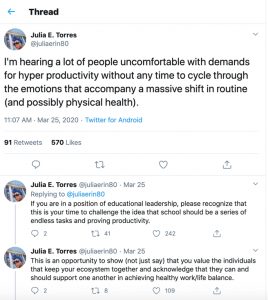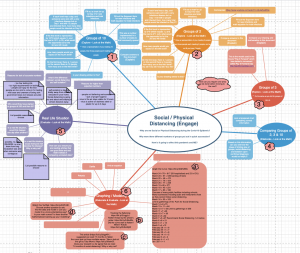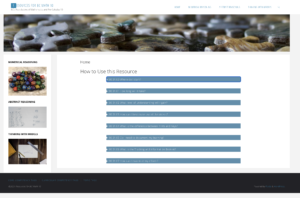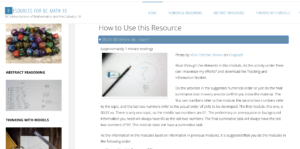
This thread helped me recognize something about myself. When the crap hits the fan, I go into ‘hyperspeedproductivity’ to deal with the fallout and the causes. In my school administration job, I would hopefully have anticipated the situation through creative planning. This is probably why I was encouraged to take the type of administration position I had, even though I never had any intention of ever becoming an administrator. I recognize that I am not normal in my reaction to unexpected situations, but I believe I developed this because of being involved in the arts and starting to teach piano and singing lessons at age 14. You never knew what was going to happen when performing and it all had to come out smelling like roses in the end. And at the end of two weeks of social distancing and ten days after the announcement that schools would close, I hit the crash.
So, recap.
What did I do when we were told to hunker down and social distance and I have no school classes to prepare for? I signed up for two other courses to support my final MedTech project development. One is a Google Educator Level 1 Certification because a friend is offering it for free with her support when needed. It may be the answer to how I can host my final project without it being a cost to me monetarily (though I am still a little concerned about the privacy). The other one is on Indigenous histories and contemporary issues in Canada from an indigenous perspective.
These choices help with escapism from the Coronavirus news, have an indoor focus since I can’t spend much time outside with this being my prime allergy season therefore tricky for my asthma (and my inhaler appears to be in short supply so I was caught short for a week), and they are something positive to do when I need to back off from the social/physical distancing math inquiry project I am creating for this course and my final project.
It is timely that we were required to read Buchanan’s “Wicked Problems in Design Thinking”. Unfortunately, I think my inquiry project is a wicked problem; the real-life component doesn’t really have a solution as the data may not be accurate due to a number of considerations and we still do not have a full understanding of the coronavirus that is requiring the social/physical distancing. Plus, new models and data is being released daily. Maybe that will make the final guided inquiry problem interesting for students to consider after they look at the basic math they need to apply. Hopefully, because it is wicked, it will also be a lasting and useful math exercise.

I attempted to organize the inquiry as a controlled investigation with opportunities to reflect on the real-life applications through research and information literacy. (Levels of inquiry referred to match Trevor Mackenzie’s Levels of inquiry.) My hope is that students will then move on to guided inquiry within the topic, showing their ability to be creative. There is so much math that can be explored through this lens, including using digital citizenship skills by debunking the profuse fake news that uses inaccurate math or displays it poorly. I also included a link to Hans Rosling’s Ted Talk on statistics as inspiration for innovation in showing the math they discovered.

The designing of the task (above) took way longer than I expected because it kept growing and changing. I have created inquiry tasks before, and reading Galileo’s website resonated, but because I am not creating for a specific class of students, the process took quite long. By trying to be extremely inclusive, it is almost spiraling out of control. As the Galileo website suggests under ‘What is inquiry?’ article, the problem is authentic, has applications well beyond the school, requires the use of digital technologies (and literacies which are outlined) and encourages active exploration and connecting with experts. The open inquiry suggested has academic rigour potential for multiple grade levels, and I have suggested assessment methods for the teachers I sent it to (if they want to use it as assessment). I left out the opportunity to communicate with other students as that will be left up to the teacher. The task is really meant to be used as a jumping off point for an International Baccalaureate Middle Years Programme criterion B (Investigating Patterns) assessment after the controlled inquiry section (which would take place under ‘test’ conditions) and then the final guided project would be a criterion C (Communicating) and criterion D (Applying Mathematics in Real-Life Contexts) assessment task. These criteria have three to five strands each which delineate eight levels of achievement.
Then, the crash.
I didn’t want to do ANYTHING but my first marked blog was due. Darn.
Our professor recognized the unique situation we were in and extended the deadline on our blog post (which I had planned to be this one). Therefore, this blog reflects two weeks of ‘work’. I spent a few days doing diddly and then set myself a deadline to share the assignment out (and therefore stop daily ‘improvements’). I got going and finished the Social Distancing Inquiry Task (or as finished as any of these types of inquiries get). In the development of the task, I used EZGif again and Google Draw for the first time. I still want to go in and edit the task, but I am leaving the editing for others so they have some ownership. I am keeping a list of items I may want to add for future times when I will use it.
Plans to convert the task to something anyone could use without having it in a proprietary software like Microsoft Powerpoint or Google Slides didn’t pan out. Supposedly, Slides should open if a student has a Google anything, but if they don’t, Apache OpenOffice Impress should open the slides as an open source freeware option. Even the conversion to Slides lost some of the functionality of Powerpoint, so I still have to check opening the Slides in Impress, but I will leave that for another week. It will be linked to my final project, so at that time, I will ‘license’ it as part of that open educational resource.
For now, please try out the task or pass it on to someone who may want to use/edit it! It works best for the student in presentation mode.
Resources:
Apache OpenOffice Impress
Buchanan, R. (1992). Wicked Problems in Design Thinking Design Issues: MIT Press, Vol. 8, No. 2 (Spring, 1992), pp. 5-21, retrieved from http://web.mit.edu/jrankin/www/engin_as_lib_art/Design_thinking.pdf
EZGif
From the Ashes – CBC Canada Reads
Galileo (2019). Designing Learning. Retrieved from https://galileo.org/designing-learning/ (Inquiry and Design Thinking)
Google Educator course into – https://teachercenter.withgoogle.com/fundamentals/course
Google Draw
Indigenous course – https://www.coursera.org/learn/indigenous-canada/home/welcome
Microsoft Powerpoint
Unsuccessful free powerpoint to video converters – https://www.ispringsolutions.com/blog/top-10-powerpoint-to-video-converters
https://elearningindustry.com/turn-your-presentation-into-an-interactive-elearning-course–
https://www.zamzar.com/convert/ppt-to-html5/









Recent Comments